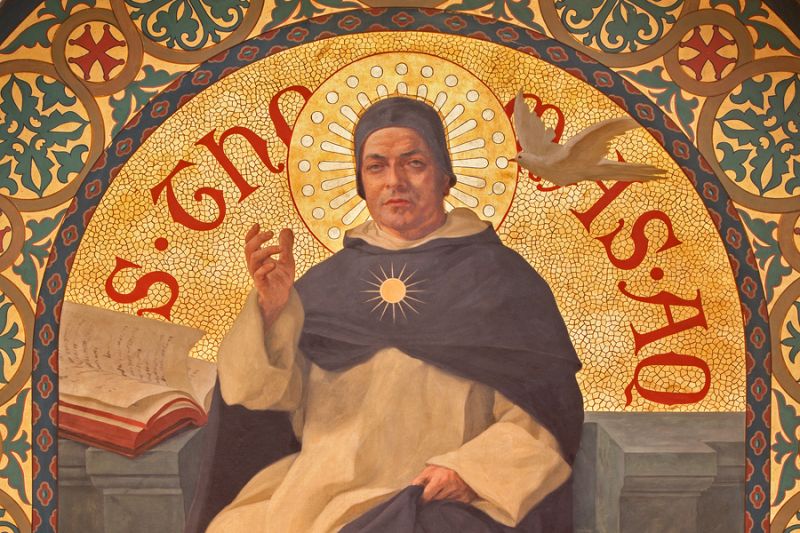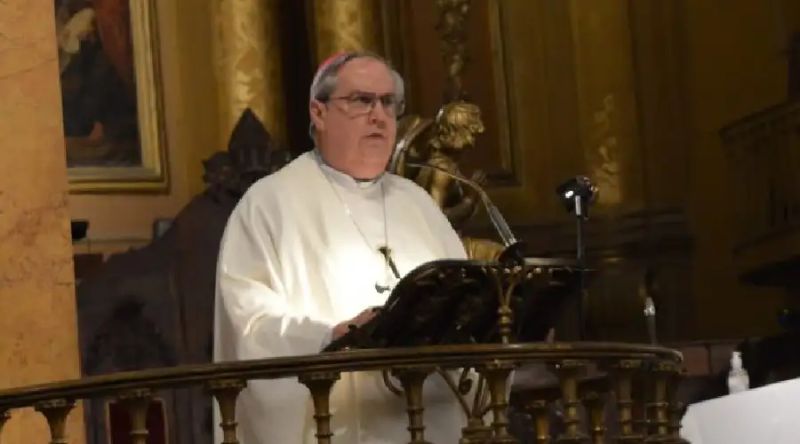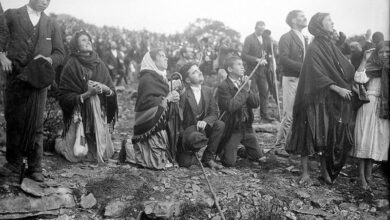A profile in courage: Cardinal Kung and Catholic resistance in Shanghai
 Bishop Ignatius Kung Pin-Mei in 1949. / Credit: Public Domain
Bishop Ignatius Kung Pin-Mei in 1949. / Credit: Public Domain Rome Newsroom, Sep 8, 2023 / 06:00 am (CNA).
On the evening of Sept. 8, 1955, public security officers of the Chinese Communist Party (CCP) launched a mass arrest of Catholic clergy in the city of Shanghai. Among them was the first native-born bishop of the city, Ignatius Kung Pin-Mei. By the end of the month, over 1,200 priests and lay faithful were arrested, interrogated, and imprisoned.
This carefully orchestrated event was the culmination of a multiyear process by the CCP to break Catholic resistance in the city and to bring the Church under the control of the state. The decision to focus on Shanghai was deliberate: It was the hub of the Catholic Church in China and Cardinal (then bishop) Kung was not only one of the most important Catholic leaders in the country but also the very embodiment of unwavering fidelity to the Petrine office.
Born into a fifth-generation Catholic family
The Catholic life of Shanghai was profoundly shaped by the French Jesuits. They took over ecclesiastical affairs following the Sino-French conventions of the 19th century, which ushered in the French religious protectorate. Shanghai, an important port city, was a sort of laboratory, a meeting point of different cultures, and it was in this environment that the Jesuits were able to integrate the Church into the broader social framework. The city was also home to the most important Catholic schools and seminary, as well as the main Marian shrine, Our Lady of Shehan.
It was in this cosmopolitan environment that Ignatius Kung Pin-Mei was born in 1901 into a fifth-generation Catholic family. Known for his piety, pastoralism, and administrative acumen, following his ordination to the priesthood in 1930 he went on to serve as a principal of a Jesuit middle school and high school. Not only did these schools provide many with a solid academic formation, but they also became places where non-Catholic Chinese youth encountered the faith, many of whom converted and became fervent Catholics.
A hostile environment for the Church
Though the Church had a stable presence in China since the late 16th century, in broader Chinese society there was a lingering suspicion of Catholics. This was a result of the historic link between the European imperial powers and mission work, which in turn delayed the indigenization of the episcopate. In 1924 the Primum Concilium Sinese (the first Plenary Council of China), or the Shanghai Synod of Bishops, addressed many of these concerns. Then, finally, in 1926, the first six native Chinese bishops were consecrated by Pope Pius XI in 1926. Twenty years later, in 1946, Pope Pius XII in his apostolic constitution Quotidie Nos erected an official diocesan structure in China.
There is a canonical as well as a socio-political significance to these developments. Before 1946, the ecclesiastical administrative units in China were apostolic prefectures or pre-diocesan administrative units in mission territories. Having native-born Chinese bishops and an official diocesean structure elevated the position of the Chinese Church, signaling to the world that it was an equal, not a mission territory governed by foreigners. However, the ascendancy of the CCP was on the horizon and the narrative of a “foreign” or “imperial” Church was still prevalent.
The People’s Liberation Army (PLA) entered Shanghai on May 24, 1949, and the CCP’s takeover of mainland China was complete on Oct. 1, 1949, when the People’s Republic of China was established. That same year Kung was made bishop of Suzhou, a new diocese erected by the Holy See, and was personally consecrated by papal internuncio Antonio Riberi.
On Aug. 5, 1950, following a prolonged vacancy, Kung was appointed bishop of Shanghai, though it wasn’t until Oct. 7 (on the feast of Our Lady of the Rosary, a date chosen by Kung) that he was consecrated. Becoming a bishop in the climate of Maoist China was an unenviable position: Bishops were a vital link to Rome, a visible representation of papal authority and, by virtue of that, a main target for the party. For Kung, there was much consternation about the future as he knew the party would act swiftly against the Church.
The end goal of the CCP was to isolate Chinese Catholics from Rome and to create an independent “patriotic” Church. To do this they adopted a multi-pillar strategy that consisted of levying high taxes (and ultimately expropriating) Church property, implementing education reform — the “thought-reform” campaign — to align school curriculum with Marxian tenets, and developing a surveillance apparatus to monitor the movement of the clergy (especially foreign missionaries). These measures were coupled with an intense propaganda campaign to discredit the foreign missionaries and to delegitimize the Holy Father. The party gave an ultimatum: to either register with the government and denounce the pope or face social ostracism and imprisonment.
To oversee the process of nationalizing religion, the party created the Religious Affairs Bureau, today called the National Religious Affairs Administration, which was predicated upon the Three-Self Patriotic Movement (self-government, self-support, and self-propagation). While Protestant churches were easier to nationalize, due in part to their more decentralized structure, the Catholic Church was particularly vulnerable not only due to the complex history of the missions but also because of the Church’s inherent universality, embodied in the figure of the Roman pontiff.
Kung laid groundwork for underground Church
Pope Pius XII, as was the case for many of his predecessors, considered communism as not just a political ideology but a new religion. Responding to the rapidly deteriorating situation in China, in Ad Sinarum Gentem (“To the Chinese People”) he excoriated the establishment of a national church, which “could no longer be Catholic because it would be the negation of that universality or rather ‘catholicity’ by which the society truly founded by Jesus Christ is above all nations and embraces them one and all.”
Kung knew he would be arrested, and to maintain the long-term survivability of the Church he needed to prepare the laity to pass down the faith. Kung, with the help of many priests and faithful Catholics, built up an impressive network in Shanghai that allowed the Church to continue operating. This took the form of clandestine catechism groups (an initiative first spearheaded by the priest Beda Chang, who is considered the first Catholic martyr of the Church in Shanghai) and preaching sessions.
As more parishes and administrative offices had been surveilled and raided, foreign missionaries were expelled and Chinese clergy arrested. Lay Catholic associations, such as the Legion of Mary, played a crucial role in disseminating information around the diocese and maintaining networks of communication. In effect, Kung had managed to lay the groundwork for the formation of what would become the underground Church.
His arrest and refusal to acquiesce
Kung’s arrest on Sept. 8, 1955, was one of the last major blows to Catholic resistance. That night more than 300 priests and lay Catholics were arrested. For the party, years of patience and propaganda had paid off. The so-called “Kung Pin-Mei counterrevolutionary clique” had been eradicated. Following his arrest, there were further arrests as well as indoctrination sessions. Many broke down, accused Kung of counterrevolutionary activity, and registered with the government.
Despite attempts by interrogators, Kung refused to acquiesce to the party’s demands and legitimate the patriotic church. Shortly after his arrest, when asked to denounce the pope in a public stadium, Kung defiantly yelled in front of the crowd, “Long live Christ the King. Long live the pope.” He spent the next five years in prison and in 1960, during a show trial, he was given a life sentence in prison.
In prison, he was subjected to often horrific conditions and went through extended periods of intense solitary confinement. According to someone familiar with the cardinal’s time in prison, he was often kept on his floor and the prison guards were told to not interact with him. He was also denied medical care and visits from humanitarian organizations such as the Red Cross. According to the source, one package that was sent to the cardinal was returned as said prisoner “did not exist.”
The goal was to break his resolve and his spirit and yet his faith never wavered. Those familiar with the cardinal’s story recounted how while in prison he would recite the Mass in Latin by memory and the cardinal, who had a strong Marian devotion, prayed the rosary using only his fingers.
Despite the pressure, Kung never succumbed, seen in his 1979 appeal letter where he reiterated: “To separate from the sole representative of Jesus Christ on earth, the Roman pontiff, is to make myself losing the most basic Catholic faith, becoming a heretic without the pope … This is a serious issue in the history of the holy Catholic Church for which millions of people have fought by shedding their blood and sacrificing their lives.”
In the 1980s, following the excesses of the cultural revolution, China was going through a period of “opening up” to soften its image abroad and attract foreign investment. In 1985 Kung went on parole. Though it was supposed to last five years, in 1988 after having served only half of the term, he was inexplicably released. He went to the United States at the age of 88 to receive medical treatment — despite his wishes, he never returned to China.
Though created a cardinal “in pectore” by Pope John Paul II in 1979, it wasn’t until June 29, 1991, in a public consistory that he was introduced to the world as Cardinal Kung. Following the consistory, the pope said: “I felt that the whole Church could not but honor a man who has given witness by word and deed, through long suffering and trials, to what constitutes the essence of life in the Church: participation in the divine life through the apostolic faith and evangelical love.”
Then-Cardinal Joseph Ratzinger in 1999 commended Kung for his courage and faith.
“In your decades of fidelity to the Church, you have followed the example of Christ the Good Shepherd, and even in the face of great suffering, have not ceased to proclaim the truth of the Gospel by your words and example. For your faithful witness to Christ, the Church is deeply grateful.”
Kung died in 2000 at the age of 98. Like many, he wanted to be a good Catholic and a good citizen, but he was caught between living his faith authentically or compromising with the government. He always maintained “I am a good citizen. I was born and brought up in China.” This sentiment was reflected by Pope John Paul II in a message of condolence where he said the cardinal was “a noble son of China and a noble son of the Church.”
Nearly 70 years after his arrest, Kung is remembered as he preached fidelity to the Successor of Peter and to the Church and exemplified this with his own life. An individual familiar with the situation of the underground Church in China told CNA: “The underground Church is wounded, but it is alive, there are vocations; the faith is being passed down from generation to generation.”
Just as he played a crucial role in maintaining the faith in China, Kung continues to provide an example of faith, hope, and courage to those Catholics and to persecuted Catholics the world over.





